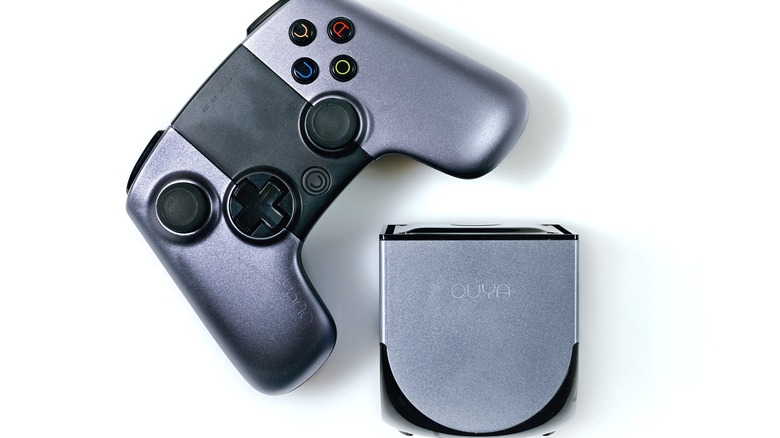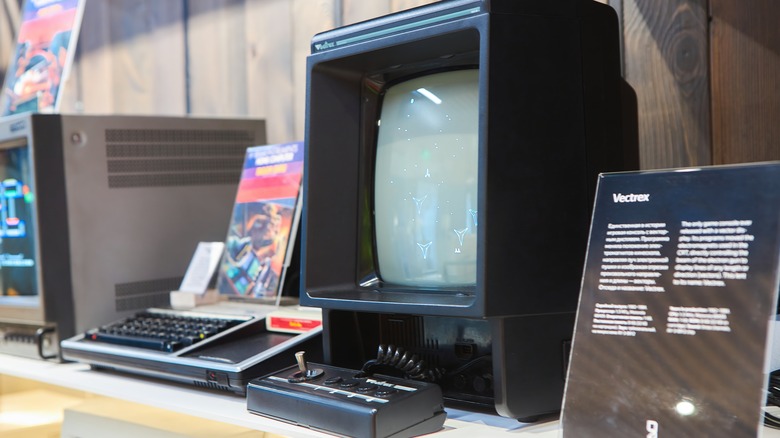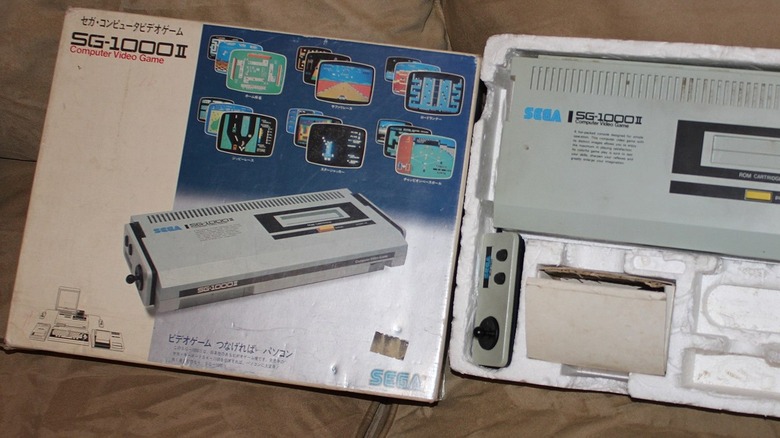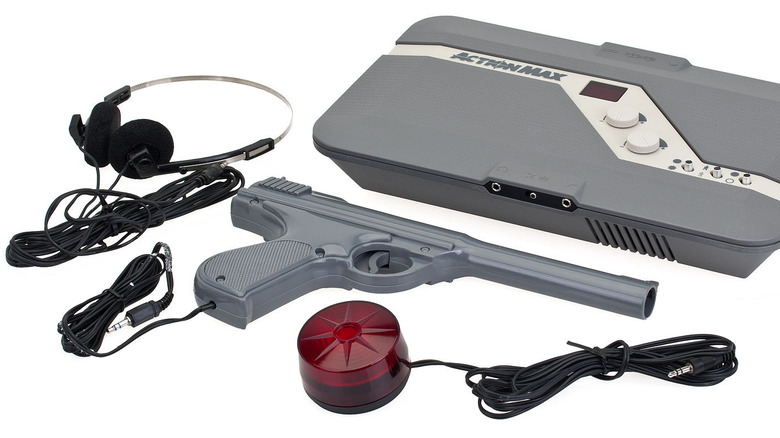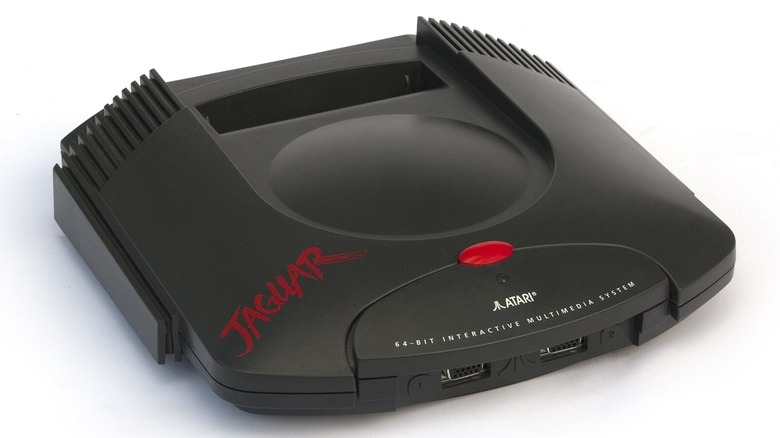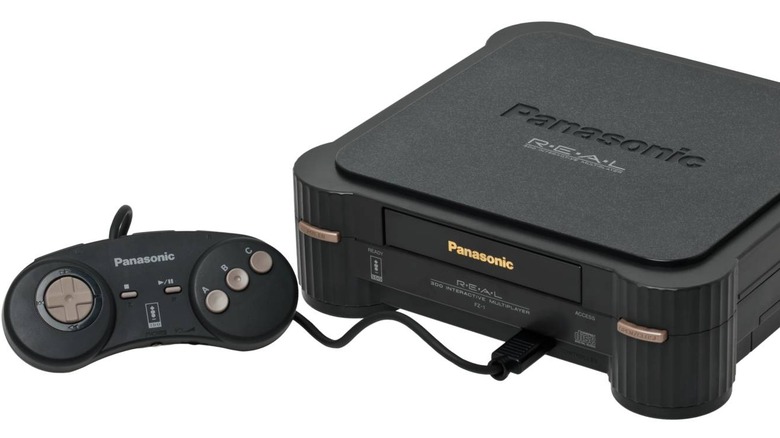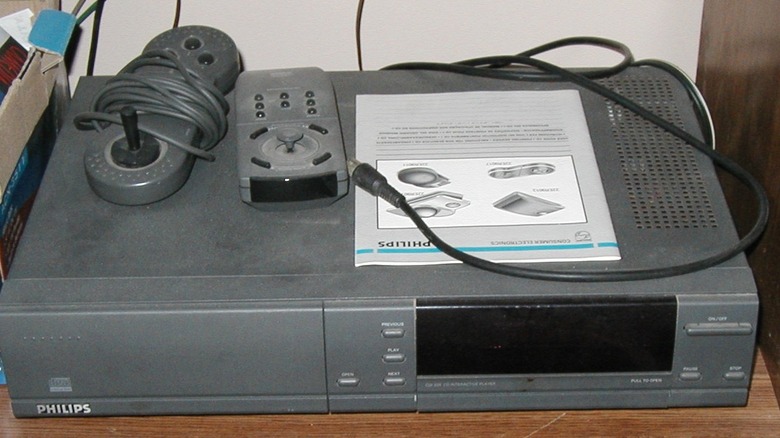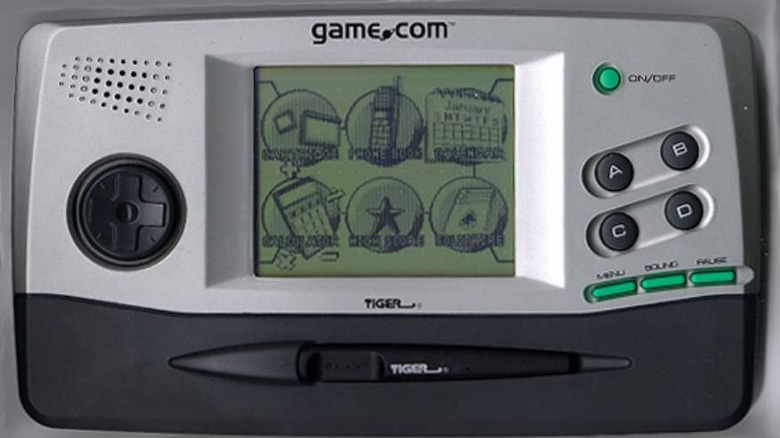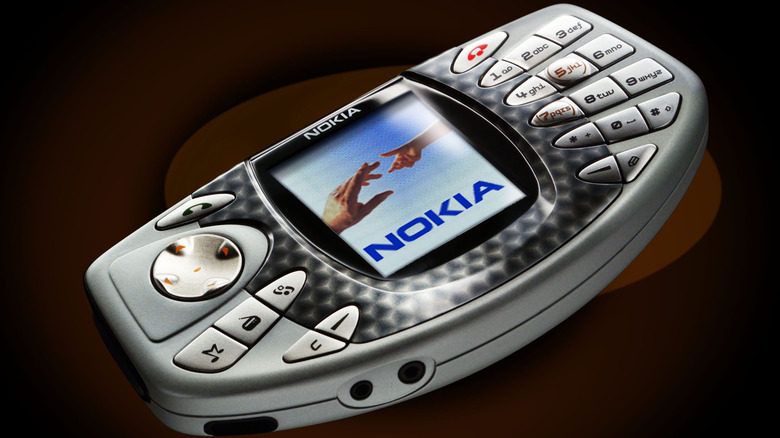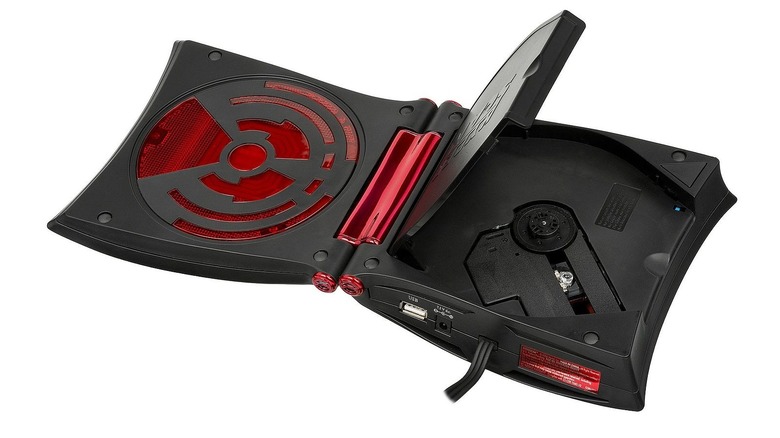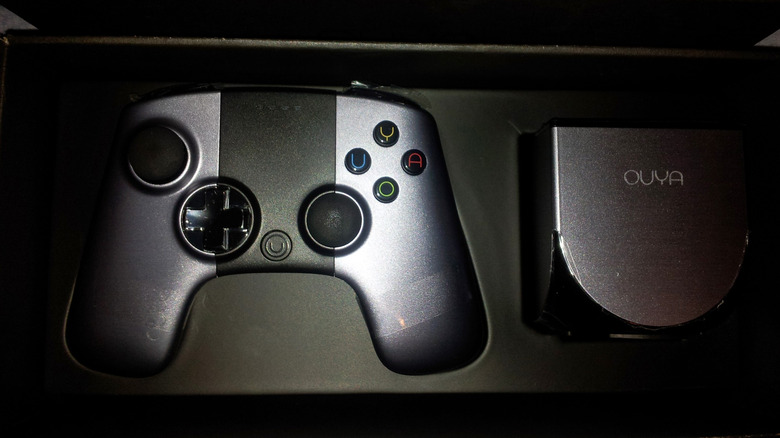10 Discontinued Gaming Consoles You've Probably Forgotten About
Many people can almost track the milestones and trajectory of their lives through when they owned various iconic video game consoles. Maybe you grew up with the likes of the Sega Dreamcast and Nintendo 64, or your entertainment space is filled with devices like the Nintendo Switch, Steam Deck, and PlayStation 5. So many of these devices have brought countless hours of joy over the years.
Of course, you don't need an article to tell you how awesome a Switch is. In fact, the Nintendo Switch has nearly become the best-selling gaming console of all time, beating out the PlayStation 2 in the process. But not every new development that emerges makes a similar dent to those successes within the never-ending console wars. We're not talking about infamously unwieldy gaming peripherals like the Wii remote or the trident-like Nintendo 64 controller — there are whole consoles you may have completely forgotten about.
You may be hearing about some of these items for the first time here, because they were such spectacular failures, their companies promptly filed them away (or went out of business altogether), never to be heard from again. Some of these devices can sell for a ton of money on eBay these days because they're so rare, despite how the general public wanted nothing to do with them at the time of their release. However, while they represent the lower echelons of the video game console hierarchy, they may be worth a second look.
Vectrex
Home video game consoles began manifesting in the early 1970s. People no longer needed to head to the arcade to play their favorite games when they could bring the entertainment to their living rooms. The early '80s saw a push in this technology, with the Nintendo Entertainment System (NES) easily being one of the most popular of the era. During this time, something else came out that never really received a fair shake — the Vectrex.
Unlike other consoles, the Vectrex didn't require a plug-in to a television set. It came with its own screen, so people could play without taking up perhaps the only TV in the house. Launched in late 1982, it was basically like having a miniature arcade cabinet in your home. It never caught on in the same way as the NES, but it brought several noteworthy innovations. For starters, it was the first console to feature 3D capabilities, and owners could purchase goggles to take advantage of these effects. With a built-in monitor and unique library, the Vectrex really could've been onto something had it not been for the infamous video game crash of 1983.
This industry-wide recession rocked the video game market, with the Vectrex merely being one casualty. It was discontinued in 1984, and plans to develop a handheld version never came to fruition. These days, Vectrex consoles occasionally pop up on sale on eBay, making for a cool, retro addition to anyone's video game collection.
SG-1000
Sega saw plenty of success in the video game console market, even if Sony managed to outclass the company overall in the console wars. Still, any success came in spite of Sega getting into the market on some rocky footing with the SG-1000. It's understandable if you've never heard of the device, as it was only released in Japan (as well as Australia and New Zealand in limited numbers), but it showed how Sega had a lot to learn when it came to making fun video game systems.
The SG-1000 released on July 15, 1983, which just so happened to be the very same day Nintendo came out with its Famicom in Japan (called the NES when it launched in the U.S. in 1985). That's some tough luck right there, as the SG-1000 just didn't match up to the Famicom. Former Sega consumer hardware development head Hideki Sato wrote about the setbacks of the SG-1000 on a post to Shmuplations: "We were lacking adequate staff to develop the software for our new system, too. Consequently, I don't think we put out very good games back then."
Game recognition was clearly a huge issue — the Famicom released with home versions of "Donkey Kong" and "Donkey Kong Jr," and nothing Sega had at the time could compete. However, while the SG-1000 may have faltered, it set the stage for more Sega successes in the ensuing years.
[ Featured Image by 1779Days via Wikimedia Commons | Cropped and scaled | CC0 ]
Action Max
Many folks likely grew up playing "Duck Hunt" and know how the game worked. You'd point the toy gun at a target on the screen, and based on your accuracy, you could rack up points (or have a dog laugh at you if you were bad). "Duck Hunt" and similar titles were immensely interactive games with a ton of replay value. And in comparison, it's kind of easy to see why the Action Max console from 1987 fizzled.
The Action Max required players to have a VCR for which they could input VHS tapes. These tapes would contain the "gameplay," which involved you trying to shoot ghosts or planes or whatever the targets might be. And therein lies the integral problem: The VHS tape is a fixed item. Things would blow up on the screen, but it wasn't because you were any good. It could monitor how accurate you were and provide you with a score, but if you went back to replay it, you would always see the same footage.
And whereas something like the NES could support a bunch of different kinds of games, the Action Max had one gimmick — shooting simulations. If you weren't into that, this console wasn't for you, and it quickly went off the market. Only five games were ever released for the Action Max, and they likely ended up collecting dust in a corner while kids went over to their friends' houses to play "Duck Hunt."
[ Featured Image by Evan-Amos via Wikimedia Commons | Cropped and scaled | CC BY-SA 3.0 ]
Atari Jaguar
Atari was synonymous with video games throughout the 1980s, but the '90s saw it push the boundaries of what consoles were capable of. The result was a crash that ultimately led to Atari getting out of the console market entirely. Say hello to the Atari Jaguar.
The main thing the Jaguar had going for it during its North American release in 1993 was that it was the first 64-bit gaming system. This was a few years before the Nintendo 64 would come out, so Atari had a leg-up on the competition. Sadly, the console couldn't deliver on the marketing promises. The Jaguar was plagued with controversy as video game aficionados claimed the console wasn't actually a 64-bit device but instead two 32-bit processors working in tandem. It also didn't help that many of the games that came out alongside the Jaguar, like "Cybermorph" and "Trevor McFur in the Crescent Galaxy," failed to impress. It was discontinued in 1996.
These days, the Atari Jaguar is a bit of a novelty, selling on sites like eBay for between $400 and $1,000. In 2022, the Jaguar made headlines once again when Atari released "Atari 50: The Anniversary Celebration," a compilation set of classic Atari games, including some titles for the Jaguar.
[ Featured Image by Bilby via Wikimedia Commons | Cropped and scaled | CC BY-SA 3.0 ]
3DO
Time Magazine listed the 3DO Interactive Multiplayer console as one of the best products of 1993. The device could play movies from CDs as well as video games, effectively aiming to be a one-stop-shop for people's media centers. It's not a bad idea, and the concept of video game consoles also being able to play movies would be incorporated later on, making the 3DO a trendsetter of sorts. Unfortunately, no one wanted to pay for it.
When the 3DO first came onto the market, it was listed at $700, with some stores selling it for much more. The Super Nintendo Entertainment System had a starting price point of about $199 when it first came out, so it was naturally a tough sell trying to get people to fork over triple the money, even if it could play movies from CDs. The price came down over time, but the damage was done. Hundreds of games would become available for the 3DO across its short lifespan thanks to the company's liberal licensing policies, but this also included a lot of games that probably shouldn't have been released, further diminishing the console's reputation.
Today, the 3DO's legacy is mostly for being the first home of "Gex," which would go on to have sequels on PlayStation and Nintendo consoles. Some might say bringing the world Gex the Gecko is more than enough for one console to achieve.
[ Featured Image by Evan-Amos via Wikimedia Commons | Cropped and scaled | CC BY-SA 3.0 ]
Philips CD-i
The Philips CD-i also failed to make much of an impression in the early 1990s, but it produced some awkward cut scenes from a Mario game that have blown up on YouTube. Surely, the millions of dollars spent to create those animations were worth it for that alone.
Similar to the 3DO, the CD-i tried to bite off more than it could chew by offering a CD input system that would allow users to play games, listen to music, and watch movies. It also became the most expensive video game console ever launched, with a starting price of $1,000. Clearly, Philips had lofty ambitions for this device — it even entered into a partnership with Nintendo to create the console specifically under that brand's banner. Nintendo eventually pulled out of the deal to make its own console, but the agreement still allowed Philips to release some hilarious off-brand Nintendo titles, including the aforementioned Mario game called "Hotel Mario" and a few "Legend of Zelda" games that had nothing to do with the mainline series.
However, the promise of some new Zelda games wasn't enough to entice people to fork over a grand to get the system, and it only sold about 570,000 units worldwide. The Philips CD-i was finally put to rest in 1998, but luckily, those wonky Mario and Zelda animations will live on YouTube in perpetuity.
[ Featured Image by Gordon P. Hemsley via Wikimedia Commons | Cropped and scaled | CC BY-SA 3.0 ]
Game.com
If you come for the king, you best not miss. In the late 1990s, Game Boys ruled supreme: The Game Boy and Game Boy Color are still among the best-selling video game consoles of all time. It would be a fool's errand to try to compete with Nintendo in the handheld arena, but Tiger Electronics gave it a shot anyway with its Game.com console. It went about as well as you'd expect.
The Game.com tried to offer features you couldn't get with a Game Boy, such as a touchscreen and internet connectivity. But this was the late '90s. Actually using its internet capabilities required purchasing additional accessories. It should come as no surprise that when the updated model, known as the Game.com Pocket Pro, came out, internet connectivity was ditched entirely.
Trying to get internet connectivity on a handheld device was a worthy thought, as people could theoretically check out emails from their video game system. And perhaps it would've been forgiven had it had a decent selection of games. There were titles in the works that would've built off the popularity of "A Bug's Life" and "Godzilla," but those never came to pass, as the Game.com was discontinued in 2000, coincidentally around the same time as the Dot-com bubble burst.
[ Featured Image by Empani via Wikimedia Commons | Cropped and scaled | CC BY-SA 3.0 ]
Nokia N-Gage
Calling modern-day smartphones "phones" really does a disservice to what they can accomplish — these devices now offer internet browsing, gaming, and more. The Nokia N-Gage tried to offer that kind of multifunctionality back in 2003, but the world wasn't ready ... especially for such an unwieldy package. It should become clear just by looking at the device why the Nokia N-Gage was a complete failure.
The N-Gage was meant to take a bite out of Game Boy Advance sales by enticing people with a handheld gaming device that also worked as a phone. It was easy to make fun of for its taco-shaped design, but in addition to merely looking odd, it wasn't really practical as a gaming console. Since the device was a phone, it required the traditional 12-digit phone pad so that people could make calls. These were also the buttons you needed to play games. It became inconvenient quickly.
To its credit, Nokia partnered with major developers to create recognizable titles for the N-Gage, offering games like "Tomb Raider" and "FIFA Football 2004." Nokia had high hopes, with projections to sell 6 million units of the N-Gage in three years, but only 2 million were sold, leading to the device's discontinuation in 2006.
Mattel HyperScan
As mentioned before on this list, many discontinued video game consoles suffered due to exorbitantly high prices. The Mattel HyperScan could've seemingly avoided this problem, as the console launched at just $69.99, a steal compared to some other devices on the market. And in theory, the console could've continued bringing in profits on just a single game, as the gimmick involved players purchasing trading cards with RFID chips you could scan into a game to load new characters and abilities. It's sort of like an early precursor to Amiibos, but as a way to appeal to those who collected "Yu-Gi-Oh!" or "Magic: The Gathering." Sadly, the HyperScan couldn't outpace the competition.
The device was flimsy in its construction, its RFID scanning was unreliable. And you don't have to look far to find people online talking about how bad the games were. Only five games ever came out for the HyperScan, including ones for "Ben 10" and "Spider-Man," but the system really didn't go beyond that. Despite launching in 2006, it was promptly shuttered just a year later.
Despite the low price, it makes sense people didn't rush out to get a HyperScan. Having to continually buy trading cards to access all of the content in a given game seems just as potentially annoying as modern micro-transactions, especially if the games weren't great. Plus it was competing with the Xbox 360, Nintendo Wii, and PlayStation 3 — not a great time to break into the market.
Ouya
There was a lot of promise to the Ouya, but much like Icarus, it may have flown too close to the sun. The idea behind it was novel: Offer gamers an affordable console focusing primarily on indie games while providing developer tools so that individuals could develop their own games to potentially get on the system. This was a crowdfunded venture, and it would become one of the most successful Kickstarter campaigns in history, bringing in $8.5 million.
Unfortunately, when the Ouya came to fruition, it had one issue after the next. First, there was the matter of shipping out units to people who backed the project, with problems materializing quickly. There were promises from the company behind Ouya that it would continue working on the device, but the product everyone got simply didn't live up to the hype. The Verge wrote in its review, "Ouya isn't a viable gaming platform, or a good console, or even a nice TV interface. I don't know what it is, but until Ouya figures it out, it's not worth $99."
Ouya's software was sold to Razer in 2015, and it was discontinued that same year. Online support was still offered until 2019 before the console and its assets received a merciful death. The Ouya represented a more utilitarian vision of gaming's future where people didn't have to spend an arm and a leg for a console and could develop their own games by hacking the system's software. Like many Kickstarter-based projects, the Ouya just couldn't deliver on its grand ambitions.
